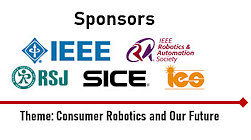




 |
Technical Program for Wednesday October 28, 2020 |
Open all abstracts Close all abstracts |
| WeOS | Room T24 |
| Awards | Awards ceremony |
| Chair: Oh, Paul Y. | University of Nevada, Las Vegas (UNLV) |
| Co-Chair: O'Malley, Marcia | Rice University |
| 08:45-09:00, Paper WeOS.1 | |
| Awards | |
| Oh, Paul Y. | University of Nevada, Las Vegas (UNLV) |
| O'Malley, Marcia | Rice University |
| WePL | Room T25 |
| Plenary 3 | Plenary session |
| Chair: Oh, Paul Y. | University of Nevada, Las Vegas (UNLV) |
| Co-Chair: O'Malley, Marcia | Rice University |
| 09:00-10:00, Paper WePL.1 | |
| Living with Social Robots: From Research to Commercialization and Back | |
| Breazeal, Cynthia | MIT |
| WeAT5 | Room T5 |
| Semantic Scene Understanding I | Regular session |
| Chair: Indelman, Vadim | Technion - Israel Institute of Technology |
| Co-Chair: Murillo, Ana Cristina | University of Zaragoza |
| 10:00-10:15, Paper WeAT5.1 | |
 Video Attachment Video Attachment | |
| Kong, Xin | Zhejiang University |
| Yang, Xuemeng | Zhejiang University |
| Zhai, Guangyao | Zhejiang University |
| Zhao, Xiangrui | Zhejiang University |
| Zeng, Xianfang | Zhejiang University |
| Wang, Mengmeng | Zhejiang University |
| Liu, Yong | Zhejiang University |
| Li, Wanlong | Beijing Huawei Digital Technologies Co., Ltd |
| Wen, Feng | Huawei Technologies Co., Ltd |
| 10:15-10:30, Paper WeAT5.2 | |
 Video Attachment Video Attachment | |
| Yu, Bangguo | Shandong University |
| Chen, Chongyu | Sun Yat-Sen University |
| Zhou, Fengyu | Shandong University |
| Wan, Fang | Shandong University |
| Zhuang, Wenmi | Shandong University |
| Zhao, Yang | School of Electrical Engineering and Automation, Qilu University |
| 10:30-10:45, Paper WeAT5.3 | |
 Video Attachment Video Attachment | |
| Spencer, Steven J. | Sandia National Laboratories |
| Parikh, Anup | Sandia National Laboratories |
| McArthur, Daniel | Sandia National Laboratories |
| Young, Carol | Sandia National Laboratories |
| Blada, Timothy | Sandia National Laboratories |
| Slightam, Jonathon E. | Sandia National Laboratories |
| Buerger, Stephen P. | Sandia National Laboratories |
| 10:45-11:00, Paper WeAT5.4 | |
 Video Attachment Video Attachment | |
| Tchuiev, Vladimir | Technion Israel Institute of Technology |
| Indelman, Vadim | Technion - Israel Institute of Technology |
| 11:00-11:15, Paper WeAT5.5 | |
| Zhang, Guanghui | Shanghai Institute of Microsystem and Information Technology, Ch |
| Zhu, Dongchen | Shanghai Institute of Microsystem and Information Technology, Chi |
| Ye, Xiaoqing | Baidu Inc |
| Shi, Wenjun | Shanghai Institute of Microsystem and Information Technology |
| Chen, Minghong | Bionic Vision System Laboratory, State Key Laboratory of Transdu |
| Li, Jiamao | Shanghai Institute of Microsystem and Information Technology, Chi |
| Zhang, Xiaolin | Shanghai Institute of Microsystem and Information Technology, Chi |
| 11:15-11:30, Paper WeAT5.6 | |
| Alonso, Iñigo | University of Zaragoza |
| Riazuelo, Luis | Instituto De Investigación En IngenieríadeAragón, University of Z |
| Montesano, Luis | Universidad De Zaragoza |
| Murillo, Ana Cristina | University of Zaragoza |
| WeKN1 | Room T27 |
| Keynote 9 | Keynote session |
| Chair: Oh, Paul Y. | University of Nevada, Las Vegas (UNLV) |
| Co-Chair: O'Malley, Marcia | Rice University |
| 15:45-16:30, Paper WeKN1.1 | |
| Human + Robot Teams, from Theory to Practice | |
| Thomaz, Andrea Lockerd | University of Texas at Austin |